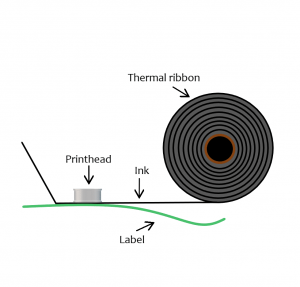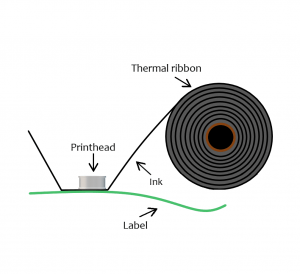Chemical resistance is the resistance level of the label to certain chemical substances
Chemical Resistance
Clear PP Labels
Coated Paper
Coated Paper is paper that has been coated on the surface
Coated Side Out (CSO)
Coated Side Out (CSO)Coated Side Out (CSO) means the inked side of a thermal transfer ribbon is facing outside. When using CSO ribbons, set up the ribbon properly so that it unrolls from... More means the inked side of a thermal transfer ribbon is facing outside. When using CSO ribbons, set up the ribbon properly so that it unrolls from the bottom. To tell where the inked side is, simply look for the matt side of the ribbon.

Coating
The coating is a material or a substance used to cover surfaces conducive for decoration and/or protection from harsh environmental conditions. It also provides a printable surface
Colour matching
Colour matchingColour matching in label printing refers to the process of accurately reproducing a specific colour on a printed label. Colour matching is important to ensure consistency and accuracy across different... More in label printing refers to the process of accurately reproducing a specific colour on a printed label. Colour matchingColour matching in label printing refers to the process of accurately reproducing a specific colour on a printed label. Colour matching is important to ensure consistency and accuracy across different... More is important to ensure consistency and accuracy across different label runs, as well as to achieve the desired visual appearance for the label design.
Colour matchingColour matching in label printing refers to the process of accurately reproducing a specific colour on a printed label. Colour matching is important to ensure consistency and accuracy across different... More involves several steps, including selecting the appropriate ink colours, adjusting ink formulation and printing parameters, and fine-tuning the printing process to achieve the desired colour. The process requires careful calibration of the printing equipment, including colour management software, to ensure that the final printed label accurately matches the intended colour.
Colour matchingColour matching in label printing refers to the process of accurately reproducing a specific colour on a printed label. Colour matching is important to ensure consistency and accuracy across different... More can be a complex process, particularly when it involves matching specific brand colours or Pantone colours. Brand owners and designers may provide specific colour standards, such as Pantone colour codes, to ensure that the label colour accurately represents their brand identity.
Various factors can influence colour matching, including the type of substrate, printing method, and ink formulation. Environmental factors, such as lighting conditions and humidity, can also affect colour perception and must be carefully controlled during the colour matching process.
Colour matchingColour matching in label printing refers to the process of accurately reproducing a specific colour on a printed label. Colour matching is important to ensure consistency and accuracy across different... More is an essential part of the label printing process and requires the expertise of skilled professionals to achieve accurate and consistent results. The use of advanced colour management technology and colour measurement tools, such as spectrophotometers, can help ensure precise colour matching and provide valuable data for process control and quality assurance.
Continuous Label Rolls
Continuous Label Rolls are labels in one long strip and are not cut to size. If a printer has a cutter installed, it can cut individual labels to the desired size
Core Size
Core Size is the diameter inside of the core, usually made from cardboard. Our standard core sizes are 26mm, 41mm, and 76mm
Corner Radius
Corner Radius is the curvature of the corners of a die-cut label

